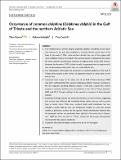Files in this item
Occurence of common dolphins (Delphinus delphis) in the Gulf of Trieste and the northern Adriatic Sea
Item metadata
| dc.contributor.author | Genov, Tilen | |
| dc.contributor.author | Kotnjek, Polona | |
| dc.contributor.author | Centrih, Tina | |
| dc.date.accessioned | 2020-08-12T11:30:03Z | |
| dc.date.available | 2020-08-12T11:30:03Z | |
| dc.date.issued | 2021-04 | |
| dc.identifier | 268202596 | |
| dc.identifier | 1c78ee03-ab0c-4db0-a2dd-6f158031caff | |
| dc.identifier | 000558333700001 | |
| dc.identifier | 85089288214 | |
| dc.identifier.citation | Genov , T , Kotnjek , P & Centrih , T 2021 , ' Occurence of common dolphins ( Delphinus delphis) in the Gulf of Trieste and the northern Adriatic Sea ' , Aquatic Conservation: Marine and Freshwater Ecosystems , vol. 31 , no. S1 , pp. 69-75 . https://doi.org/10.1002/aqc.3407 | en |
| dc.identifier.issn | 1052-7613 | |
| dc.identifier.uri | https://hdl.handle.net/10023/20449 | |
| dc.description.abstract | 1. The Mediterranean common dolphin (Delphinus delphis), considered to have been very common in the past, had undergone a dramatic decline across most of the basin by the end of 1970s. In the northern Adriatic Sea, one of the regions with most available historical information, the common dolphin is thought to have been the most common and abundant cetacean throughout most of the 20th century. However, by the end of 1970s, it had virtually disappeared from the region and is now considered generally absent from the entire Adriatic Sea. 2. This contribution summarizes the occurrence of common dolphins in the Gulf of Trieste and provides a brief review of published records in other parts of the Adriatic Sea. 3. Systematic boat surveys in the wider area of the Gulf of Trieste between 2002 and 2019 confirmed that the common bottlenose dolphin (Tursiops truncatus) is the only regularly occurring cetacean species in this area. Despite this, several records of common dolphins were documented in the Gulf of Trieste between 2009 and 2012, through sightings of live animals or recovery of dead stranded animals. 4. Dorsal fin markings allowed the photo‐identification of some of these, suggesting that at least four different live individuals (three adults and one calf) occurred here in recent times. Most cases involved single adult individuals, but one included a mother‐calf pair that was temporarily resident in a port for several months, a behaviour atypical for this species. Photo‐identification showed that the presumed mother had previously been sighted in the Ionian Sea in Greece, over 1,000 km from the Gulf of Trieste, making this the longest documented movement for this species worldwide. 5. At present, the common dolphin continues to be rare in the region. | |
| dc.format.extent | 7 | |
| dc.format.extent | 28576790 | |
| dc.language.iso | eng | |
| dc.relation.ispartof | Aquatic Conservation: Marine and Freshwater Ecosystems | en |
| dc.subject | Adriatic Sea | en |
| dc.subject | Common dolphin | en |
| dc.subject | Delphinus delphis | en |
| dc.subject | Distribution | en |
| dc.subject | Gulf of Trieste | en |
| dc.subject | Mediterranean Sea | en |
| dc.subject | Photo-identification | en |
| dc.subject | GC Oceanography | en |
| dc.subject | QH301 Biology | en |
| dc.subject | DAS | en |
| dc.subject | NIS | en |
| dc.subject.lcc | GC | en |
| dc.subject.lcc | QH301 | en |
| dc.title | Occurence of common dolphins (Delphinus delphis) in the Gulf of Trieste and the northern Adriatic Sea | en |
| dc.type | Journal article | en |
| dc.contributor.institution | University of St Andrews. School of Biology | en |
| dc.identifier.doi | 10.1002/aqc.3407 | |
| dc.description.status | Peer reviewed | en |
| dc.identifier.url | https://onlinelibrary.wiley.com/toc/10990755/2021/31/S1 | en |
This item appears in the following Collection(s)
Items in the St Andrews Research Repository are protected by copyright, with all rights reserved, unless otherwise indicated.

